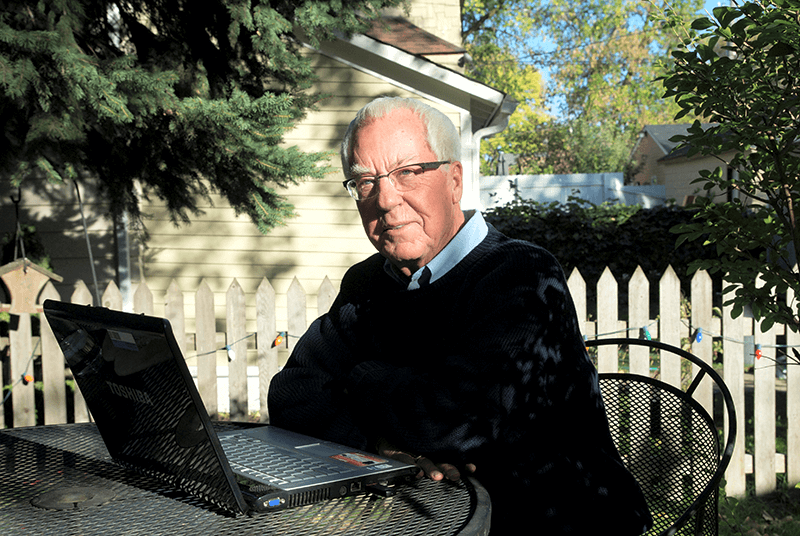Nowhere Street is closer than you think. It’s in more than one place, and it keeps moving, too. It’s under bridges, and in the lobbies of bus stations late at night. Hundreds of homeless youths meander Nowhere Street every night in the U.S., and the solution to getting them off of that street and into homes eludes our best efforts for a myriad of reasons. These homeless children, the complicated motivations that push them to the streets and the struggle to find safe places for them to live are the focus of “On Nowhere Street: Jennie’s Journey,” the most recent novel by longtime WCCO newsman-turned-mystery-author Ron Handberg.
The author
Handberg spent his entire career in journalism, starting in 1960 when he landed a summer job working for WCCO as a radio reporter. By his retirement in ’89, he’d worked his way up through the ranks as news director, and, finally, vice president and general manager of WCCO-TV, but all that time in the field hadn’t worn him out. After 29 years of writing the news, Handberg, who makes his home in Northeast, wanted to fulfill a longstanding dream to write novels.
Handberg’s initial spark for writing was ignited in high school, when a teacher and the assistant principal commended him for a writing assignment he turned in. His path eventually led him into journalism, but he always credited the first step of that path to the encouragement he’d gotten in creative writing.
“To have that kind of recognition that young,” he mused. “It created a young writer.”
Handberg’s first novel, “Savage Justice,” was published in 1992, just a few years after his retirement. It followed the path of a journalist investigating corruption in the Minnesota court system, and, as with all six of his subsequent books, was inspired by real events.
“When I first sat down and tried to think of what to write about, my wife told me, ‘Write what you know,’” Handberg explained. In the moment the words left her mouth, he decided the genre he’d write: mystery and crime thrillers. Drawing on his experience covering news in Minnesota for nearly three decades, Handberg began to weave stories that retold tales of deceit, corruption and murders most foul, viewed through the exploits of a crew of enterprising journalists from an underdog TV station in a fictionalized version of Minneapolis.
The story
Handberg’s books all share a “universe,” so to speak. Events from one book usually impact, or are at least mentioned, in the next, and characters make reappearances throughout all of them. His most recent book, “On Nowhere Street” sees a few returning faces; the heroine of the story, journalist Gabby Gooding, was also the lead in his previous book, “Dead Too Long.” You don’t have to have read any of Handberg’s previous books to understand what’s going on in “On Nowhere Street;” each book is a stand-alone story that nods to its predecessors.
“On Nowhere Street” tells a dual-pronged story, in which Gooding is approached by a homeless girl who hopes the news can help her find a missing friend, as she doesn’t feel safe going to the cops. Gooding, who immediately smells a good lead, soon finds her commitment to her job at odds with her empathy as she divides her efforts between chasing a missing person story that gets increasingly out of hand and protecting the vulnerable youth who brought her the tip.
When picking subjects for his books, Handberg looks for real-life headlines that tell a story deeper than what day-to-day news can tell with limited air time or column inches. He wants to tell stories that focus on social issues of the day, but with the more personal touch that fiction can achieve. After being inspired by a Star Tribune writer’s work on the topic, “On Nowhere Street” brought forward a subject matter that Handberg felt doesn’t get much attention in fiction: youth homelessness.
“As I was thinking of a storyline [for On Nowhere Street], it just kept running through my head,” he said. “I was still bound to make it a mystery, because that’s what I do. … But I thought, ‘How can I help bring attention to a societal problem in these late years of my life?’”
Handberg spent four years writing “On Nowhere Street,” nearly twice as long as his other books. A good deal of the time was spent on research, since homelessness is a particularly heavy topic, especially where homeless youths are concerned. He wanted to be accurate and respectful with the subject matter, while telling a story that had impact.
The Review
Handberg was obviously very passionate about the subject of this book. The extra time he spent researching it shows through in the very human face he puts on youth homelessness. The character of Jennie, the homeless girl who sets off the whole chain of events in the book, empathetically exemplifies one of many different kinds of kids who end up on the street. The book goes into excruciating detail humanizing the idea of homeless kids, as Gooding and her crew’s research brings them in contact with more and more of the stories from the street. Some of the people they meet are fleeing violent homes, some have fallen on hard times, some are mentally ill, some are violent, and some just like life on the street.
Much like the real-life inspiration for the story, there’s no easy solution, and what seems like a surefire way to get Jennie off the street becomes more complicated the harder Gooding tries. Meanwhile, the thickening plot of the missing girl, Hannah, continues to pull her away from trying to set things right. While the story starts as a joined-at-the-hip parallel tale of a hard-nosed reporter and a homeless kid both seeking the truth in different ways, the reader, much like Gooding, soon finds themself more wrapped up in the mystery of Hannah than the plight of Jennie.
But perhaps that was the point?
Throughout the book, Gooding’s crew frequently reminds her of the kind of news that sells and that homeless kids aren’t going to get the same traction as a missing person search. In spite of that, Gooding returns to her quest to get Jennie to safety, risking her career in the process. In this way, Handberg did a good job in tying his thesis together with the diverging mystery plot in the end.
Despite the care he put into the book, Handberg said there’s still so much work to be done to help homeless youth, and he just hopes that his book helps stir some people’s hearts to do what they can about it.
“For someone to write a nonfiction piece [on youth homelessness] would be a wonderful project to see,” said Handberg. “These kids still have a chance at life, but their path is so often blocked.”

Ron Handberg. (Provided)

Northeast author Ron Handberg’s new book deals with teen homelessness in a mystery novel with a TV newsrooom backdrop. (Provided)